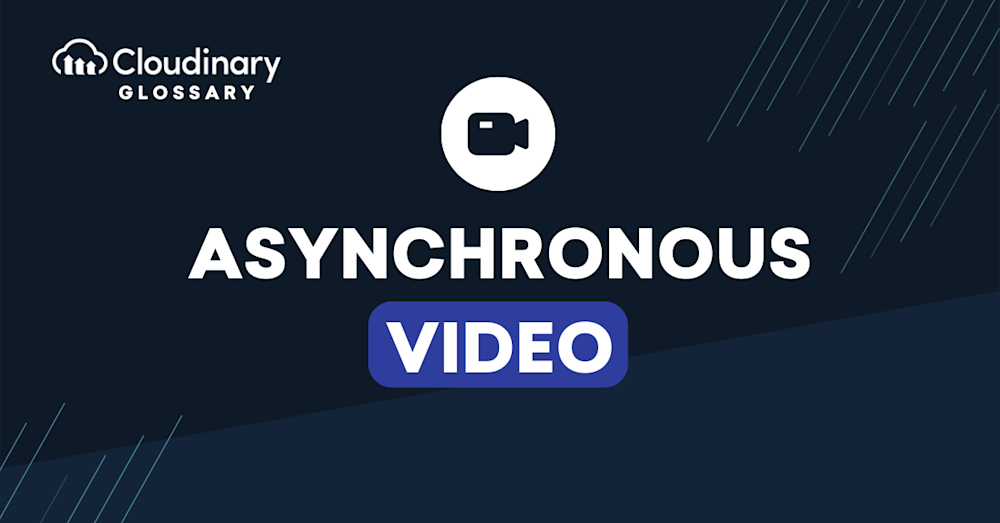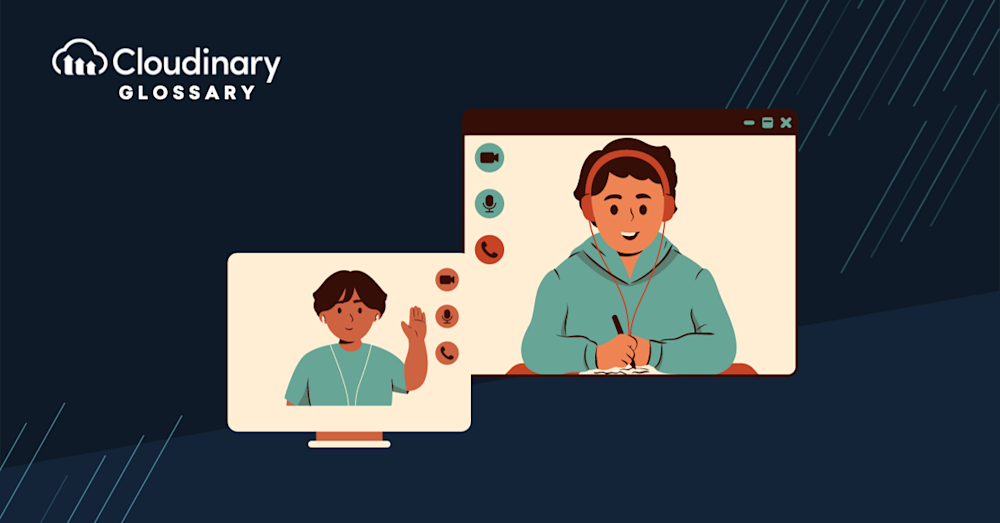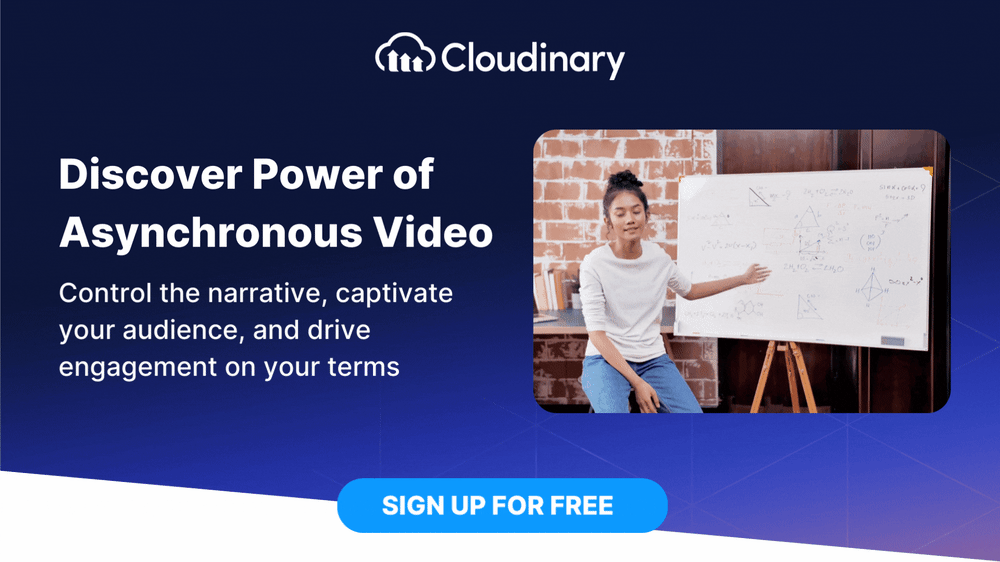In this article:
- What Is Asynchronous Video?
- The Importance of Asynchronous Video
- Pros and Cons of Asynchronous Videos
- When Should You Consider Asynchronous Videos?
What Is Asynchronous Video?
Asynchronous video is a type of digital communication that allows individuals to share and consume video content at their own pace without coordinating schedules or participating in live, real-time sessions. In this format, video messages or presentations can be pre-recorded and uploaded to a platform or sent directly to specific individuals, who can view these recordings on their own time, pausing, rewinding, or rewatching as needed. This alleviates the pressure and constraints commonly associated with traditional video conferencing and enables more flexible, inclusive, and accessible communication.
It also opens the door to more thoughtful, well-prepared communication—creators of asynchronous content can refine their message, minimizing misunderstandings and ensuring clarity. Plus, these videos are often archived and searchable, which means viewers can revisit them later for reference or training.
This approach can be particularly advantageous in various professional and educational settings, as it permits individuals with differing work hours, time zones, or personal obligations to engage effectively with colleagues, clients, or educators. In a world that continues to embrace remote work and digital collaboration, asynchronous video is an increasingly popular tool for enabling efficient communication and learning while accommodating diverse needs and preferences. Meanwhile, synchronous video remains vital for situations that require immediate feedback and real-time discussion.
Tools like Loom, Vidyard, and CloudApp have made asynchronous video creation easier than ever, allowing users to record their screen, camera, or both, and share detailed updates, walkthroughs, or explanations without needing a live audience.
The Importance of Asynchronous Video
The digital era has changed how we communicate, and asynchronous video has emerged as a key tool. It’s easy to see why asynchronous video has gained notable significance. For instance, consider a scenario where you collaborate with team members in different time zones; asynchronous video helps erase those geographical and time-bound barriers, fostering smoother communication.
It’s not just about convenience or ease of use, though. Asynchronous video also serves the crucial role of enhancing the richness and depth of communication. Traditional texts or emails may not convey the complete story as they lack the vital nuances of communication, like tone and non-verbal cues, which a video can seamlessly capture. Unlike live video meetings, where discussions happen in real-time, asynchronous videos provide the flexibility to review content multiple times, ensuring clarity and retention.
More importantly, they can help reduce the number of live meetings—especially in remote environments where video call fatigue is real. By shifting project updates or recurring feedback sessions to async video, teams avoid constant Zoom fatigue while still staying aligned.
Whether onboarding new hires in a company, facilitating student-teacher interaction in an online class, or building personal connections in a remote workspace, asynchronous videos pave the way for comprehensive and engaging communication not bound by scheduling conflicts.
What’s the Difference Between Synchronous and Asynchronous Videos?
Synchronous videos, also known as live or real-time videos, require immediate user engagement and interaction. They are typically streamed and viewed in real-time, such as live events, webinars, video conferences or video calls. On the other hand, asynchronous videos can be pre-recorded, edited, and uploaded for playback at any time, offering users greater flexibility in when and how they consume the content.
The asynchronous approach also allows messages to be saved, organized, and indexed, creating a searchable knowledge base that teams can reference later—something that’s not possible with most live meetings.
Pros and Cons of Asynchronous Videos
Asynchronous videos, like any technology, come with their own set of advantages and drawbacks. This tool’s impact and utility largely depend on how it’s employed and the specific needs of the individuals and organizations using it.
Pros
- Flexibility for content creators and viewers to engage with the material at their preferred time.
- The ability to rewatch content, supporting improved understanding, especially for complex topics.
- Increase in accessibility catering to individuals in different time zones or with differing schedules.
- Efficiency in communication by reducing the number of meetings and giving senders time to organize their thoughts.
- Enhanced clarity—since senders can plan their message, they’re less likely to miss key points or cause confusion.
- Easily archived and searchable for future reference or documentation purposes.
Cons
- The absence of real-time interaction can limit immediate feedback and spontaneous discussion.
- Asynchronous communication might feel less personal, potentially impacting relationship building.
- Dependence on tech infrastructure – users must have a reliable internet connection and devices to record and view content.
When Should You Consider Asynchronous Videos?
Given the varied landscape of digital communication, selecting the right tool for your specific needs is essential. Asynchronous video stands as a favorable option under several scenarios. Let’s delve into a few examples where using asynchronous video can be highly advantageous.
Project Updates in Global Teams
Coordinating schedules across different time zones for a synchronous meeting can be challenging when working with a globally distributed team. Asynchronous videos can provide a convenient medium for critical project updates, allowing team members to stay informed and engaged at a time that works best for them. They’re also ideal for internal feedback—team leads can record review comments on deliverables or respond to questions in detail without needing to book yet another meeting.
Product Launches or Demonstrations
If you’re looking to introduce a new product or conduct a demonstration, asynchronous video serves as an ideal tool. These videos allow the audience to understand the product at their own pace, and by controlling the narrative completely, you can highlight all essential points effectively, creating a supportive environment that can enhance face-to-face interactions later. You can also integrate these recordings into onboarding or marketing materials for long-term use, making them more scalable than one-off live presentations.
E-Learning
In e-learning, the asynchronous video takes a front seat, providing educators and students unparalleled flexibility and accommodation. Pre-recorded lessons can be paused, replayed, or stopped as required, enabling students to learn at their own pace. Async video shines in flipped classrooms or blended learning models, where learners can absorb lecture material at home and then apply or deepen their understanding through interactive activities during the live sessions.
Ways to Use it with Your Students
Asynchronous video isn’t just flexible—it’s also incredibly versatile in educational settings. Beyond pre-recorded lectures, here are a few key ways educators can use it:
- Pacing: Students can pause, rewind, and revisit content, allowing them to learn at a speed that works for them.
- Differentiation: Tailor content to suit different learning levels, styles, and language needs without overwhelming the group.
- Cooperative Learning Projects: Students can contribute asynchronously to group videos, promoting collaboration even outside classroom hours.
- Connecting Experience with Education: Encourage learners to submit video reflections or project updates that tie real-world experiences to course material.
- Video interviews: Educators can assign mock interview tasks or solicit responses via video, enabling students to reflect deeply and practice presentation skills in a low-pressure format.
On-demand Entertainment
The rise of on-demand video streaming platforms like Netflix, Amazon Prime, and Hulu is a testament to the growing popularity of asynchronous video in the entertainment industry. Unlike traditional broadcast television that operates on a schedule, these video-on-demand services let viewers binge-watch their favorite shows, tune into a film, or explore a documentary series whenever they choose.
Mastering Asynchronous Video Communication with Cloudinary
Whether engaging with a remote team, providing educational content, launching a new product, or delivering binge-worthy entertainment, the asynchronous format offers a distinct advantage by accommodating diverse schedules, time zones, and viewing preferences. Despite a few cons, like lacking real-time interaction or requiring a stable tech infrastructure, the many benefits of flexibility, controlled narrative, and wide accessibility make it a tool well worth considering.
Cloudinary’s powerful media management platform allows you to easily upload, store, optimize, and deliver your asynchronous video content. Seamlessly embed videos on any device or platform, ensure fast and reliable playback with adaptive streaming, and provide a delightful user experience for your audience.
Embrace the power of asynchronous videos with Cloudinary and unlock the ability to deliver personalized, scalable, and engaging video experiences.
Interested in more from Cloudinary?:
-
- Learn more about Video Transformations
- Dive into Media Optimization
- Discover How to manage and deliver videos at scale





